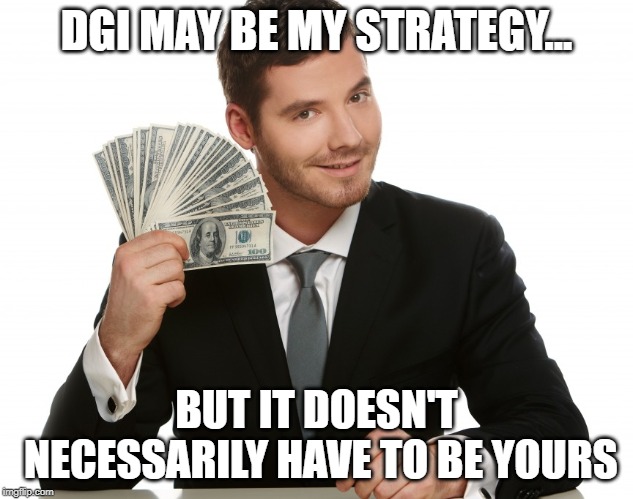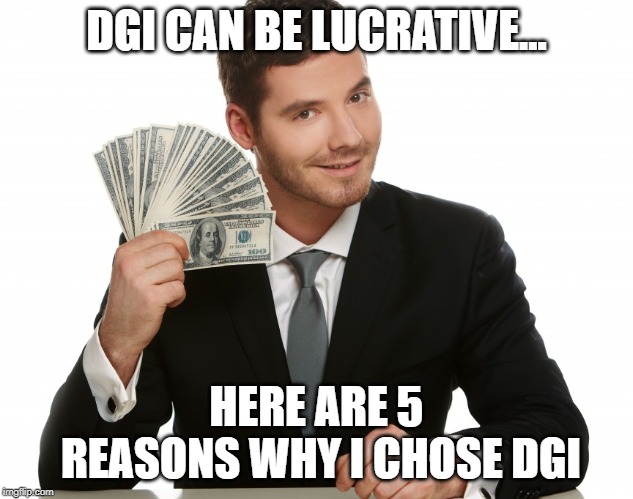
First Reason: Maybe They Have No Strategy And Underestimate DGI
It's entirely possible that one may underestimate the power of DGI and feel the need for a get rich quick strategy. Sadly, no viable get rich quick strategy exists. If it did, do you really think some "expert" would teach you for just 5 easy payments of $19.95? The dreaded short-term trader mindset is unfortunate because there are hundreds of fantastic companies out there for investors to choose from and own over the long-term, rather than rent for the short-term with the hope of making a profit. This short-term mindset is the very reason most investors underperform the market.
It's the long-term mindset coupled with aggressive savings that have allowed idols of mine such as Jason Fieber to unlock financial independence at such an early age to enable them to live their ideal life. Jason's story is absolutely incredible and really demonstrates the power of DGI better than I could even put it into words. It's absolutely breathtaking what a high savings rate and DGI is able to accomplish in such a relatively short amount of time.
Sure, you probably won't be able to support a lifestyle in which you buy a Lamborghini for each of your vacation homes on every continent besides Antarctica while also maintaining closets full of $5,000 suits through DGI. DGI isn't exactly a way to a quick windfall like winning the lottery or anything, but it's actually a viable and reproducible way to build wealth unlike winning the lottery.
But the real takeaway is that regardless of whether you need $20,000 a year to meet your expenses or $500,000, the concept of DGI is viable for both of those needs. You simply need to be able to identify excellent companies and what the fair value is for those excellent companies. Then it's just a matter of consistently investing capital in those types of companies at or below fair value for 5, 10, 15, or 20+ years, and the results become meaningful.
But it's completely understandable that many just go by what the financial media tells them and maybe some of these people without a real strategy simply don't have the time to educate themselves enough to be disciplined and rational with their investment strategy, which leads me into the next point.
Second Reason: Maybe They Don't Have The Time Commitment Or Passion Necessary
In the world we find ourselves in, many people simply don't have the time and/or passion necessary to commit to learning an investing strategy such as DGI or growth investing. It is very time consuming initially and there is quite a bit to learn in terms of analyzing companies and determining reasonable prices to pay for ownership in such companies, not to mention the occasional monitoring that goes into all these investment holdings.
While Americans technically benefit from the marvelous advances in technology over the past century, many have used that extra "free time" to grind it out at work in the hopes of moving up the corporate ladder and generating more income. And as long as they are keeping their major 3 expenses (housing, food, transportation) under control, I certainly don't blame them for doing so. After all, you can only cut expenses so much before there is nothing left that you can realistically cut.
While I'm not going to say income is completely infinite, just about all of us could be doing more to increase our income for the better of our financial futures if that is a priority for us in our own lives.
Learning new skills can increase one's value to society and if they would like a more hands-off approach to investing, index investing is absolutely, without a doubt, the best investment strategy for them to do.
If Warren Buffett advises most people to choose index investing, who the heck am I to disagree? In the words of famed economist Gene Fama Jr., "Your money is like a bar of soap. The more you handle it, the less you'll have." Index investing takes out all of the emotion that often goes into investing, which reduces the risk of stupid decisions that basically all of us as humans are susceptible to. Simplicity is incredibly powerful and the utility of index investing can't be overstated.
Third Reason: Perhaps They Equate GE Dividend Cuts With A Failure Of The Strategy
Yet another reason people may not choose DGI as their investing strategy is that maybe they hear horror stories of companies like GE and steer clear of DGI because of these stories. They fail to realize that a well-diversified DGI portfolio can withstand massive dividend cuts or even dividend suspensions.
Even if a company whose dividends account for 3% of an investor's income decides to completely suspend its dividend, the likely 5-7% dividend growth from the other 97% of dividend payers. So even in a worst-case scenario with a couple of outright dividend suspensions, an investor can roughly tread water excluding inflation. It's also important to note that these dividend cuts can often be predicted.
As was the case with GE, Simply Safe Dividends predicted GE's dividend cuts by issuing dividend safety scores of 18 and 10, before the cuts in 2017 and 2018. Simply Safe Dividends has predicted 98% of dividend cuts since its formation in 2015. While there are some exceptions like small caps which have more dynamic capital allocation policies and the Pacific Gas & Electric Company wildfire disaster that have led to dividend cuts and suspensions, these are abnormalities and are the exception to the rule that investing in excellent companies with strong fundamentals over the long-term works wonders when one is properly diversified.
Although sticking with only companies of dividend safety scores higher than 60 likely won't prevent an investor from experiencing a single dividend cut over the course of their investing lifetime, it will go a very long way in doing so. After all, the selection process is arguably just as important as the occasional monitoring of investments.
If you're looking for dividend ideas, you can even visit Seeking Alpha for great ideas (including mine, I mean I had to fit that in there). I generally only present actionable and timely ideas for companies with dividend safety scores of 60+, which indicates the dividend is safe or very safe for the foreseeable future.
Conclusion:
While dividend growth investing is an incredible investment strategy for many, it simply won't be the appropriate strategy for everyone, and that's perfectly fine. The overall takeaway is that regardless of your investment strategy (be it growth investing, index investing, you name it), you absolutely MUST have the courage and conviction to stick with it through both good and bad times. You can certainly tweak or refine your strategy here and there, but abandoning a strategy every time you encounter adversity is a recipe for failure.
Discussion:
Are you a DGIer? Or are you an index fund investor? A growth investor? As always, thanks for reading and I look forward to replying to your comments.



